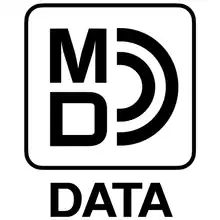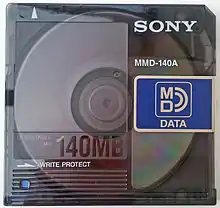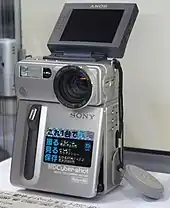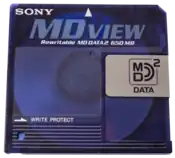MD Data
MD Data is a magneto-optical medium succeeding MiniDisc.[1] Sony wanted it to replace floppy disks, but instead came the Zip drive, CD writers, and memory sticks and cards.
 | |
 MD Data Sony MMD-140A | |
| Media type | Magneto-optical disc |
|---|---|
| Read mechanism | 780 nm semiconductor laser diode |
| Write mechanism | Magnetic field modulation |
| Developed by | Sony |
| Usage | Data storage |
| Extended from | Floppy disk MiniDisc |
| Extended to | Hi-MD |
| Released | July 1993 |
| Optical discs |
|---|
Overview
The technology has 140 MB of data storage, but it is slow and expensive. It is in products such as a still camera, a document scanner, and in late 1990s 4- and 8-track multitrack recording decks. Meant as a step up from the popular 4-track cassette-based studios, these recorders enjoyed a brief prominence before they were replaced by relatively affordable and far more flexible direct-to-hard drive recording on Windows and Macintosh based computers. The format lacks an affordable computer drive. Some examples of products that used the format are a few multitrack "portastudio"-style audio recorders such as Sony's MDM-X4 and Tascam's 564.
MD Data2
In 1997, Sony introduced the MD Data2 format at 650 MB. The only product that used the format was Sony's DCM-M1 camcorder (capable of still images and MPEG-2 video).
Hi-MD
Since 2004, Hi-MD allows 340MB or 1GB of any type of data to be stored on a Hi-MD formatted MiniDisc, succeeding MD Data and MD Data2.
Gallery
 The Sony Cyber-shot DSC-MD1 was the only Cyber-shot camera using MD Data
The Sony Cyber-shot DSC-MD1 was the only Cyber-shot camera using MD Data The camcorder Sony DCM-M1 records 20 minutes of MPEG2-Video on a MD Data2 disc
The camcorder Sony DCM-M1 records 20 minutes of MPEG2-Video on a MD Data2 disc Sony MDM-X4 Multitrack Recorder
Sony MDM-X4 Multitrack Recorder
References
- "Sony Global - Press Release - "Hi-MD" Format Established". April 27, 2006. Archived from the original on 2006-04-27.

